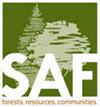在北卡罗来纳州皮德蒙特地区种植的沿海和皮德蒙特原产地尾稃松科植物的茎部缺陷率和冰风暴破坏情况
IF 1.5
4区 农林科学
Q2 FORESTRY
引用次数: 0
摘要
来自美国东南部沿海平原和皮德蒙特产地的 20 个太田松家族被种植在皮德蒙特上部的一个地点,该地点在太田松 3 岁时经历了一场严重的冰风暴。将 11 年树龄的暴风雨损害率和缺陷率与种子转移距离和种子亲本的育种值进行比较,以建立暴风雨损害率和分叉率、断茎率以及锯材潜力的预测模型。温度较高的种源家族在暴风雨中出现断肢或断茎和叶片损伤的概率较高。即使考虑到种子转移的距离,高大的树木也更有可能出现断裂和叶片损伤。感染分叉或纺锤形锈病(Cronartium quercuum f. sp. fusiforme)的树木发生折断的几率更高。肢体断裂或叶片受伤的树木锯材潜力不会降低,但茎干断裂会降低锯材潜力。暴风雨并没有导致树木立即死亡,但有严重断肢、断茎或叶片损伤的树木在 8 岁时存活的可能性较低。11岁时,分叉、直度和抗锈蚀性育种值组合最佳的家庭,预计有60%的茎具有锯材潜力,而组合最差的家庭只有30%的茎具有锯材潜力。研究意义:在更靠北和更靠内陆的地方种植来源较暖的台地针叶松(龙柏)品系可能会带来更高的生长速度,但也会带来因低温和冰风暴而受损的风险。为生产实木产品而种植的树木必须相对无缺陷,并且需要较长的轮伐期,而生物能源和纸浆木材则可以使用较小的、有缺陷的树木。本分析报告利用北卡罗来纳州上皮德蒙特地区的种植数据,根据种子来源和育种值预测了11年树龄前的缺陷率。土地管理者在选择植树造林的家庭时,可以利用这些模型来权衡收益和风险。本文章由计算机程序翻译,如有差异,请以英文原文为准。
Stem Defect Rates and Ice Storm Damage for Families of Pinus taeda from Coastal and Piedmont Provenances Planted on a North Carolina Piedmont Site
Twenty Pinus taeda L. families from both the Coastal Plain and Piedmont provenances in the southeastern United States were planted on an upper Piedmont site that experienced a severe ice storm at age 3 years. Storm damage and defect rates through age 11 years were compared with the seed transfer distance and the seed parents’ breeding values to develop prediction models for storm damage and rates of forking, stem break, and sawtimber potential. Warmer-source families had higher probability of limb or stem breaks and foliage injury from the storm. Taller trees were more likely to experience breaks and foliage injury, even after accounting for seed transfer distance. Trees with forks or fusiform rust (Cronartium quercuum f. sp. fusiforme) infection had a higher probability of breaks. Trees with limb breaks or foliage injury did not have reduced sawtimber potential, but broken stems reduced sawtimber potential. The storm did not cause immediate mortality, but trees with major limb breaks, stem breaks, or foliage injury were less likely to be alive at age 8 years. At age 11 years, families with the best combination of breeding values for forking, straightness, and rust resistance had a predicted 60% of stems having sawtimber potential, whereas families with the worst combination had 30%. Study Implications: Planting warmer-source Pinus taeda (loblolly pine) families farther north and inland may lead to greater growth but poses a risk of damage from cold temperatures and ice storms. Trees grown for solid-wood products must be relatively defect-free and require a longer rotation, whereas bioenergy and pulpwood can use smaller, defective trees. This analysis presents predictions of defect rates through age 11 years based on the seed source and breeding values using data from a planting in the upper Piedmont of North Carolina. Land managers can use these models to weigh the benefits and risks when choosing families for reforestation.
求助全文
通过发布文献求助,成功后即可免费获取论文全文。
去求助
来源期刊

Forest Science
农林科学-林学
CiteScore
2.80
自引率
7.10%
发文量
45
审稿时长
3 months
期刊介绍:
Forest Science is a peer-reviewed journal publishing fundamental and applied research that explores all aspects of natural and social sciences as they apply to the function and management of the forested ecosystems of the world. Topics include silviculture, forest management, biometrics, economics, entomology & pathology, fire & fuels management, forest ecology, genetics & tree improvement, geospatial technologies, harvesting & utilization, landscape ecology, operations research, forest policy, physiology, recreation, social sciences, soils & hydrology, and wildlife management.
Forest Science is published bimonthly in February, April, June, August, October, and December.
 求助内容:
求助内容: 应助结果提醒方式:
应助结果提醒方式:


